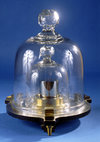 Once upon a time we lived in a society that was not only completely analog but infinitely simpler. A time when it seemed the physical world could be understood and described, perhaps even tamed, purely through the application of rational thought. Contemporaries dubbed that era the Age of Enlightenment and looked forward to the wonders that this brave new world would bring. This week, one of the last icons of that heady time was dethroned and retired to a museum in Paris.
Once upon a time we lived in a society that was not only completely analog but infinitely simpler. A time when it seemed the physical world could be understood and described, perhaps even tamed, purely through the application of rational thought. Contemporaries dubbed that era the Age of Enlightenment and looked forward to the wonders that this brave new world would bring. This week, one of the last icons of that heady time was dethroned and retired to a museum in Paris.
I am speaking, of course, about the kilogram, the last of the seven International System of Units measures to be represented by a physical object rather than an “invariant constant of nature.” But where did it come from? And why, after two hundred twenty years, has it been replaced?
The story begins with the same school of humanists that provided the philosophic justification for the French revolution which began honorably before descending into a campaign of terror. When they decided to rationalize the multiple systems of weights and measures, the results were both more benign and long-lasting, perhaps because they took their inspiration from the grand canvas of the physical world around them. The metre became the fundamental unit of length and was fixed at one ten-millionth of the distance from the equator to the North Pole. Weight, in turn, would henceforth be calculated in reference to the kilogram, defined as the mass of one decimetre of pure water at sea level at a set temperature and barometric pressure.
Eventually, five more “base units” of measurement were added to the evolving system, defined as the second (time), mole (substance), ampere (electric current), Kelvin degree (temperature) and candela (luminosity). Many more units were “derived” from the original seven as science advanced in new areas that required their own measurements, like electromagnetism.
That was all well and good, but hardly convenient. How exactly would anyone in the commercial world measure something by 1/10,000,000 of a very long distance? And calibrating a weight scale anywhere other than at sea-side on a uniformly pleasant day would, at best, require applying a variable adjustment.
Two things resulted from that quandary. The first was the creation in 1799 of physical objects that could be used as absolute reference points for base units whenever possible. And the second was the launch of a quest to replace those same artifacts.
The original reference objects were a platinum-iridium bar representing the metre and a cylinder of the same largely inert metal representing the kilogram. The latter was officially dubbed The International Prototype Kilogram (IPK), but became affectionately known as Le Grande K.
Identical copies of each were forged and sent off to various parts of the world to allow for more convenient calibration of instruments. There, they were protected from degradation inside double bell jars, from each of which the air was evacuated. The metre bar in France survived as the canonical reference all the way up to 1960, after which the fundamental unit of measure officially became equal to 1 650 763.73 wavelengths of the orange-red emission line in the electromagnetic spectrum of the krypton-86 atom in a vacuum (got all that?). And this last Monday, Le Grande K entered retirement as well.
Going forward, by international agreement, a kilogram will be universally (if not conveniently) determined anywhere in the world by employing the Planck constant in a particular fashion. This is possible, as related by the Wikipedia, because:
The Planck constant relates a light particle’s energy, and hence mass, to its frequency. The new definition only became possible when instruments were devised to measure the Planck constant with sufficient accuracy based on the IPK definition of the kilogram.
If that explanation leaves you feeling nostalgic about the convenience of a metal cylinder, I’m guessing you’re not alone.
So, why switch from simple objects anyone can understand to complex scientific instrumentation costing millions of dollars?
The simplistic answer is because even a metal as stable as the platinum-iridium employed by the French metallurgists is not totally inert. Over the more than two centuries that have passed since their manufacture, Le Grande K and its cousins have diverged in mass from each other by up to fifty micrograms. That doesn’t cut it any more in a world of nuclear technologies and moonshots, among other applications.
But in another way, the retirement of the physical artifacts of the past simply reflects our constant quest for perfection and our willingness to develop more and more sophisticated and expensive instrumentation to measure it.
Whether you believe this is a step forward or a step back will have a lot to do with whether you think our increasing dependence on complex, expensive, esoteric technology is a good thing or a bad thing. To give one under-appreciated example, our headlong rush to move all software, data and, indeed, all human knowledge into the cloud is putting us at profound risk to a massive, disabling cyberattack, or worse, a kinetic war. What happens if someday the data farms that host our financial system, the electric grid, the transportation system – in fact, everything, including the designs of the servers themselves and the silicon chips they rely upon – end up in a smoking pile of rubble?
But enough of that. Happily, Le Grande K will live on, if only as a historical curiosity displayed forlornly in a museum case in France. Here’s hoping we never have reason to take it back out of retirement.